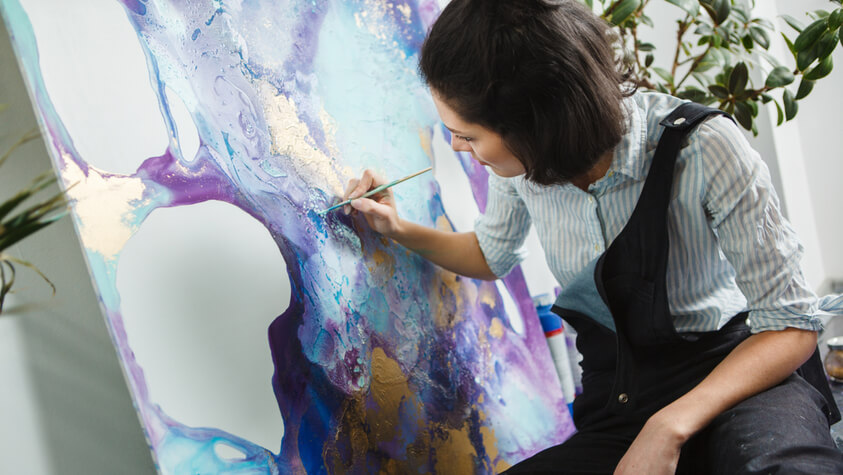By TACP Staff on July 05, 2021

Art therapists use the medium of art to facilitate expressive communication on the part of their clients. Art-based therapy enables individuals who would otherwise be unable to master self-expression to release burdensome emotions and destructive thoughts that previously remained untapped. Typically, art therapists are licensed as psychologists, counselors or therapists and have their own artistic proclivities.
Life is full of boundaries, but with art, there are no boundaries. Today, more and more people are finding that they can go beyond their perceived boundaries and gain interesting insights on their lives with art therapy.
Art therapy is a relatively new type of therapy that began sometime around the 1940’s. It is also sometimes referred to as creative or expressive therapy.
This type of therapy can be used alone or in conjunction with traditional therapy. Like traditional therapy, art therapy can be used to treat several different emotional, mental, and physical conditions. For example, art therapy can help those suffering from anxiety, depression, abuse, post-traumatic stress disorder, schizophrenia, chronic pain, or even just an overload of everyday stress.
Unlike traditional forms of therapy, art therapy requires participant to create works of art as part of their treatment. By expressing themselves through their art, it is believed that patients can improve their mental and emotional wellbeing. Many art therapy experts argue that creating art can help individuals resolve difficult issues and even reduce stress. Creating works of art can also help some improve their self-esteem and sense of self-worth.
In some instance, the act of creating the art itself may be therapy in and of itself. Patients turned artists that participate in these types of therapy programs often find that self-expression through art gives them a great sense of control. Many also find that their artwork is a type of release.
Some patients often find it much easier to communicate their thoughts and feelings through art rather than through words. The art created by art therapy patients might also contain underlying emotions and messages that are trying to break through. Interpreting these hidden aspects of a work of art can help art therapist and his patient gain a better understanding of the inner workings of the mind.
In many ways, an art therapist performs the same basic duties of a traditional therapist. He typically attempts to help his patients explore and better understand their emotional and mental conditions. As with traditional therapy, the goal of art therapy is to help patients feel better about themselves and the world around them.
To do this, an art therapist will work very closely with his patients. Art therapy sessions may be one-on-one sessions with the therapist and patient, or they may be group sessions.
An art therapist’s patients are usually individuals that have some sort of emotional, mental, or even physical problems. Many art therapists will choose to work with a certain type of person. Some art therapists might only work with patients dealing with anxiety or abuse, for instance. Others, however, may choose to work only with children or elderly patients.
The first thing that an art therapist will usually do is assess a patient in order to find out if art therapy is a fitting treatment. During this initial step, an art therapist might also confer with other mental health professionals as well.
An art therapist will then help his patients choose which form of art suits them the best. While any form of creative expression can e used during art therapy, traditional forms of art are typically used. This can include such things as painting, drawing, and sculpting.
During each art therapy session, an art therapist will encourage each of his patients to express themselves through their art. Some art therapists will even help their patients develop and hone their artistic skills. When a patient finishes a piece of art, an art therapist will usually discuss the piece and what it means with the patient.
In order to start an art therapy career, an individual must first earn a bachelor’s degree in psychology. Many aspiring art therapists are already artistic by nature, and taking several art classes while earning a psychology degree is usually recommended when chasing after an art therapy career.
A master’s degree in art therapy is also usually a requirement when starting an art therapy career. Prospective art therapy graduate students must usually submit a portfolio along with their application in order to be accepted into these programs.
In many areas, art therapists must also be certified, or licensed, just like traditional therapists. In order to become certified art therapists, art therapy graduates must pass a rigorous examination given by the Art Therapy Credentials Board. For additional information regarding psychology check out David Webb’s psychology site.
Art therapists are considered to be part of a larger group of alternative therapists known as recreational therapists. Besides using art as therapy, recreational therapists might use other activities such as games, sports, social events, and performing arts. According to the Bureau of Labor Statistics, the average salary of recreational therapists in 2017 was $47,680. Professionals of this sort in home healthcare typically earned higher salaries than professionals in other areas.
An art therapist might work in the same sort of medical facilities that a traditional therapist works in. For instance, hospitals and mental health facilities may consider hiring art therapists from time to time. Alternative medicine facilities, schools, and nursing homes might hire art therapists. Like traditional therapists, art therapists can also choose to open their own practices.
Consider these related careers in Art and Art Studies.

The Art Career Project is a trusted resource for emerging and professional artists.